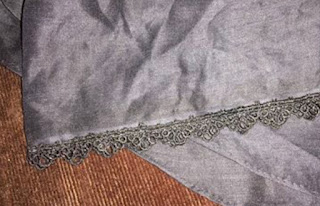Isabel Maria shares her black linen voile manto, in the category "with scarfs and fans and double change of bravery With amber bracelets bead and all this knavery" as an example of an accessory her persona would have owned and used.
"Both versions of Juan de Alcega’s Libro de Geometria, Pratica, y Traca (1580 and 1589) contain several cutting diagrams for a garment called a manto. Alcega suggests that such a garment be made of anascote, seda or clarisea. He also states that the appropriate length is from top of the head to the ankle. This would appear to suggest it is some kind of all-encompassing veil or modesty wrap. At this point I asked “how and when was this garment worn in period?”.
Marcelin Defourneaux, in Daily Life in Spain in the Golden Age, describes the wearing of the tapados (or veils) as “cloaks which completely covered them and which were pulled down over their faces, allowing only one eye to peep out.” He later quotes the Council of Castille saying (during the reign of Philip II) “The custom of women to o veiled has become so excessive that it is now prejudicial to the best interest of the state, for, because of this fashion a father no longer recognises his daughter, not a husband his wife...” and states that Philip II forbade its use, but without success. Similarly, he quotes a contemporary writer railing against the practice of folding, and refolding the veil to hide all but the left eye describing it as “a lacivious thing”.
This sounds exactly like the kind of garment any fashionable lady simply must have in her wardrobe.
Pattern
Alcega has numerous cutting diagrams showing the most efficient way to cut this garment out of different types and widths of fabric, for example:
Construction
Rather than piecing the garment as shown in Alcega, I was able to cut it out of one length, as my linen voile was sufficiently wide, unlike period fabrics. I hand stitched a narrow rolled hem around the whole piece and then added a narrow black lace to the hem based on a 1590 image found on Indumentaria y Costumbres en Espana. While the edging adds interest to the garment, it also makes it easier to control the fabric, as it is a simple matter to tell if you are gripping the edge you want, or something else.
Sadly, I haven't been able to get a picture of me wearing the manto, but here is an image of the finished item.
Verdict
This is a pretty and thoroughly inconvenient garment to wear, but perhaps that will change with practice?
Resources
- “Tailor’s Pattern Book 1589” by Juan de Alcega, translated and augmented by Jean Pain and Cecilia Bainton
- “Daily Life in Spain in the Golden Age” by Marcelin Defourneaux
- “Indumentaria y Costumbres en Espana”, entry on “Las Tapadas”. http://opusincertumhispanicus.blogspot.com/2011/11/las-tapadas.html



No comments:
Post a Comment